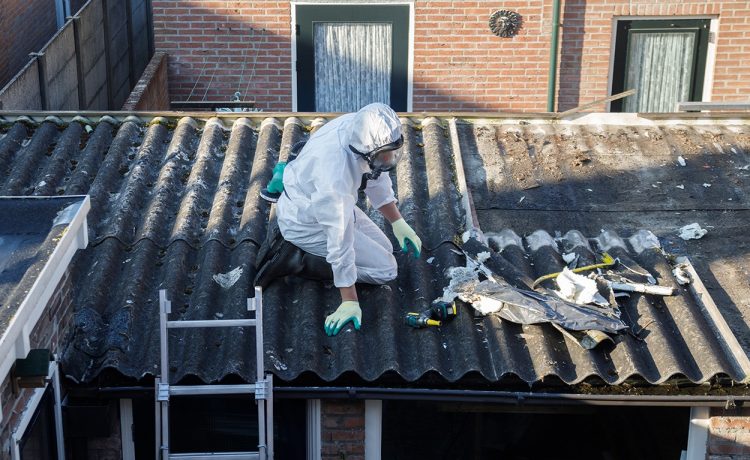The Composition and Properties of Asbestos
Asbestos is a naturally occurring mineral known for its durability and resistance to heat and chemicals. These properties made it a popular choice in construction, particularly in roofing materials. Asbestos fibers are incredibly strong, and when mixed with other materials, they create a composite that can withstand harsh weather conditions. However, the danger lies in these fibers becoming airborne, as they can be easily inhaled and cause serious health issues.
Common Uses of Asbestos in Roofing
In the past, asbestos was commonly used in various roofing products. These included asbestos cement sheets, shingles, and tiles. The material’s fire-resistant quality made it ideal for use in roofing, offering homeowners an extra layer of protection. Unfortunately, homes built before the 1980s are more likely to contain these asbestos-laden materials, posing a risk to inhabitants if the roofing is disturbed or damaged.
Historical Context of Asbestos Use
The use of asbestos dates back thousands of years, but its widespread application in construction took off during the Industrial Revolution. By the mid-20th century, asbestos was a go-to material in the building industry due to its versatility and cost-effectiveness. However, as the health risks became undeniable, regulations were introduced to curb its use. The Asbestos NESHAP regulations now provide guidance on handling and removing asbestos from homes, ensuring safety during renovations and demolitions. Despite these measures, many older homes still harbor asbestos, making awareness and proper management crucial.
Health Risks of Asbestos Exposure
Diseases Linked to Asbestos
When asbestos fibers are inhaled, they can lead to serious health issues. Asbestos exposure is primarily associated with diseases such as mesothelioma, lung cancer, and asbestosis. These conditions arise when the tiny fibers become lodged in lung tissue, causing inflammation and scarring over time. Mesothelioma, a rare cancer affecting the lining of the lungs, abdomen, or heart, is almost exclusively caused by asbestos exposure. Lung cancer linked to asbestos is similar to other types caused by smoking, but the presence of asbestos fibers increases the risk significantly. Asbestosis is a chronic lung disease resulting from prolonged exposure, leading to breathing difficulties and reduced lung function.
Long-Term Health Implications
The latency period for asbestos-related diseases is quite lengthy, often taking decades to manifest symptoms. This means individuals may not realize they are affected until many years after initial exposure. The long-term health implications are severe, with many patients experiencing a decline in quality of life due to respiratory issues and other related health problems. In some cases, the diseases are fatal. Treatment options are limited and often focus on managing symptoms rather than curing the disease.
Vulnerable Populations
Certain populations are more vulnerable to asbestos exposure and its effects. Workers in construction, shipbuilding, and industries that historically used asbestos are at higher risk. Additionally, family members of these workers can be exposed through fibers brought home on clothing. Older homes may also pose a risk to current residents if asbestos-containing materials deteriorate over time. Children and the elderly are particularly susceptible due to their developing and weakened immune systems, respectively. It’s important for these groups to be aware of the potential risks and take necessary precautions.
Identifying Asbestos in Your Roof
Visual Indicators of Asbestos
Spotting asbestos in roofing isn’t always straightforward. Older homes, especially those built before the 1980s, are more likely to have asbestos-containing roofing materials. Look for signs of wear and tear, such as cracks, breaks, or water damage. These can be clues that asbestos might be present. Asbestos was often used in roofing felt for shingles, which might look aged or deteriorated. If your roof shows these signs, it’s a good idea to proceed with caution.
Professional Asbestos Inspection
When in doubt, hiring a professional is the safest route. Asbestos inspectors are trained to identify and handle asbestos safely. They can take samples without disturbing the material too much, which is crucial since disturbing asbestos can release harmful fibers into the air. They will conduct a thorough examination and provide you with a detailed report on the presence of asbestos in your roof.
Testing and Confirmation Methods
Testing for asbestos involves collecting samples of the suspected material. This should always be done by a professional to avoid exposure. The samples are then analyzed in a lab to confirm the presence of asbestos. Results from these tests will guide the next steps, whether it’s monitoring the situation or planning for removal. Testing is a critical step in ensuring the safety of your home and family.
Legal and Regulatory Framework
Local and National Asbestos Regulations
Understanding asbestos regulations is vital for homeowners and contractors alike. Federal regulations mandate the identification of asbestos-containing materials (ACM) in residential buildings prior to demolition. This ensures safety and proper handling of hazardous materials during large-scale demolition projects. Local laws might have additional requirements, so it’s important to check with local authorities to ensure compliance. In April 2019, a final rule was established to protect the public from asbestos uses that are no longer available in the market and are not regulated by other laws.
Licensing Requirements for Asbestos Work
When dealing with asbestos, it’s not just about knowing the rules—it’s also about who can legally do the work. Professionals handling asbestos must be properly licensed and certified. This isn’t just a formality; it’s about ensuring that the work is done safely and correctly. Hiring someone without the right credentials can lead to unsafe conditions and potential legal issues.
Penalties for Non-Compliance
Ignoring asbestos laws isn’t just risky—it’s costly. Penalties for not following regulations can be severe, including daily civil fines that can reach up to $25,000. In some cases, criminal charges might be brought against violators, leading to even more serious consequences. It’s crucial to follow all legal guidelines to avoid these penalties.
Steps to Take If You Suspect Asbestos
Immediate Precautions to Implement
When you think your roof might contain asbestos, the first thing to do is not to disturb the material. Avoid any activities like drilling or sanding that could release asbestos fibers into the air. It’s crucial to keep the area as undisturbed as possible. If you need to enter the area, wear protective gear and consider sealing off the space to limit exposure. For more guidance on how to handle such situations, consider consulting with trained professionals who can safely manage the situation.
Consulting with Asbestos Professionals
It’s wise to reach out to a certified asbestos professional to conduct a thorough inspection. These experts can safely collect samples and perform necessary tests to confirm the presence of asbestos. They will follow strict safety protocols to ensure that the material is handled properly. You can find trained professionals who can conduct visual inspections of roofs and provide you with a detailed report on their findings. Once the inspection is complete, they can advise on the next steps.
Evaluating the Need for Asbestos Removal
After confirming the presence of asbestos, evaluate whether removal is necessary. This decision depends on several factors, including the condition of the material and potential exposure risks. If the asbestos is in good condition and unlikely to be disturbed, it may be safer to leave it undisturbed. However, if there’s a risk of damage or exposure, professional removal may be required. Always consult with professionals to determine the best course of action, as improper handling can increase health risks.
Asbestos Removal and Disposal
Safe Removal Techniques
When it comes to asbestos removal, it’s not a job for just anyone. Only trained experts should handle asbestos. They know how to do it safely. The process starts with sealing off the work area. This prevents those tiny asbestos fibers from spreading. Professionals might use different methods, like wet removal or special equipment, depending on the condition of the roofing material. Wet removal is often preferred because it keeps the fibers from becoming airborne.
Disposal Regulations and Guidelines
Once the asbestos is removed, it can’t just be tossed in the trash. There are strict rules about how to dispose of it. The waste needs to be packed up tight and labeled clearly. Then, it’s sent to a special facility that can handle asbestos. Not following these rules can lead to serious trouble, including fines. So, it’s important to do it right.
Hiring Certified Asbestos Removal Experts
Finding the right people to handle asbestos is crucial. Look for professionals who are certified and have experience. Check their credentials and ask for references. It’s also wise to ensure they follow all safety protocols, like using N-100 or P-100 respirators. This not only keeps them safe but also protects everyone else around. Hiring the right team means peace of mind, knowing the job is done safely and correctly.
Preventive Measures for Homeowners
Regular Roof Maintenance
Keeping your roof in good shape is essential, especially if you suspect it might contain asbestos. Regular inspections can catch issues early, preventing minor problems from becoming major headaches. Homeowners should:
- Check for any visible damage or wear, such as cracks or missing shingles.
- Clean gutters and downspouts to prevent water damage that could disturb asbestos materials.
- Schedule periodic inspections with a professional, particularly after severe weather.
Avoiding DIY Asbestos Disturbance
When it comes to asbestos, it’s best to leave it to the experts. Asbestos fibers are hazardous when disturbed, and handling them without proper training can pose serious health risks. Homeowners should:
- Refrain from drilling, cutting, or sanding suspected asbestos materials.
- Avoid sweeping or vacuuming debris that might contain asbestos.
- Consult with professionals for any repairs or renovations.
Educating Family and Neighbors
Awareness is a powerful tool in preventing asbestos exposure. Informing those around you about the dangers of asbestos can help maintain a safe environment. Consider:
- Sharing information about the risks and safety measures with family members.
- Discussing potential asbestos hazards with neighbors, especially if renovations are planned.
- Encouraging others to hire certified professionals for asbestos-related work.
Temporary Protective Measures
Encapsulation of Asbestos Materials
When dealing with asbestos in the home, immediate removal isn’t always possible or necessary. Encapsulation is a viable alternative that involves sealing off asbestos-containing materials to prevent the release of harmful fibers. This method is especially useful when the material is in good condition and not prone to disturbance. By applying a sealant, homeowners can effectively trap the fibers, reducing the risk of exposure. For more details on this technique, refer to asbestos encapsulation.
Enclosure Strategies
Another temporary measure is the enclosure of asbestos materials. This involves constructing a barrier around the asbestos to contain any potential fiber release. Enclosure is particularly effective in areas where asbestos is present but not easily removed, such as in certain roofing or wall structures. It’s a straightforward method that provides a layer of protection without the need for immediate removal.
Monitoring and Maintenance
Once encapsulation or enclosure is in place, ongoing monitoring and maintenance are crucial. Regular inspections should be conducted to ensure that the protective measures remain intact and effective. Homeowners should watch for signs of wear or damage to the encapsulated or enclosed areas. If any issues are detected, it might be time to consult with professionals to reassess the situation. In rural areas, effective asbestos removal often requires additional considerations, such as ensuring proper wetting and minimizing breakage during handling.
Understanding the Costs Involved
Cost of Professional Asbestos Inspection
When you suspect asbestos in your home, the first step is often a professional inspection. This isn’t just a quick glance; it involves thorough testing to identify asbestos presence. The cost for this service can vary widely. Typically, you might spend between $350 and $600 for a certified professional to conduct a detailed inspection. This fee provides peace of mind, knowing that the assessment is done safely and accurately.
Expenses Related to Asbestos Removal
Once asbestos is confirmed, removal is the next step. It’s crucial to hire experts for this task to avoid health risks. The expenses here can add up quickly. Asbestos removal costs for roofs range from $50 to $120 per square foot. On top of that, you’ll need to consider the cost of a new roof installation, with an average price tag of about $5,900. These figures can fluctuate based on your location and the complexity of the job.
Financial Assistance and Insurance Options
Paying for asbestos-related work can be daunting. However, there are ways to ease the financial burden. Check if your insurance policy covers any part of asbestos removal or inspection costs. Some homeowners find relief through specific grants or financial aid programs designed to assist with these expenses. It’s worth exploring these options to see if you qualify for any assistance. Additionally, discussing payment plans with asbestos removal companies might offer another avenue to manage costs more effectively.
Common Misconceptions About Asbestos
Myths About Asbestos Safety
A prevalent misconception is that asbestos poses no risk if left undisturbed. Many people believe that intact asbestos-containing materials are safe, but this assumption can be misleading and dangerous. Asbestos fibers can become airborne even from minor disturbances, posing significant health risks. It’s crucial to understand that any interaction with asbestos materials, even seemingly harmless ones, could lead to exposure.
Misunderstandings About Asbestos Removal
Another common misunderstanding is that asbestos removal is a simple do-it-yourself task. The reality is, asbestos removal requires specialized training and equipment. Attempting to remove asbestos without professional help can increase the risk of exposure.
- Hiring certified professionals ensures that the removal process is conducted safely.
- Professionals are knowledgeable about local regulations and disposal methods.
- They can also assess whether removal is necessary or if other containment measures are more appropriate.
Clarifying Asbestos Health Risks
There is a belief that only prolonged exposure to asbestos can cause health issues. However, even short-term exposure can lead to serious conditions, such as mesothelioma and lung cancer. It’s essential to recognize that no level of asbestos exposure is considered safe.
- Asbestos-related diseases often take years to develop, making it difficult to link symptoms to past exposure.
- Vulnerable populations, such as children and the elderly, may be at higher risk even with minimal exposure.
- Regular health check-ups and consultations with medical professionals are advised for those living in older homes.
For those who suspect asbestos in their homes, understanding these misconceptions can aid in making informed decisions about testing and potential removal. Learn more about the risks of undisturbed asbestos.







